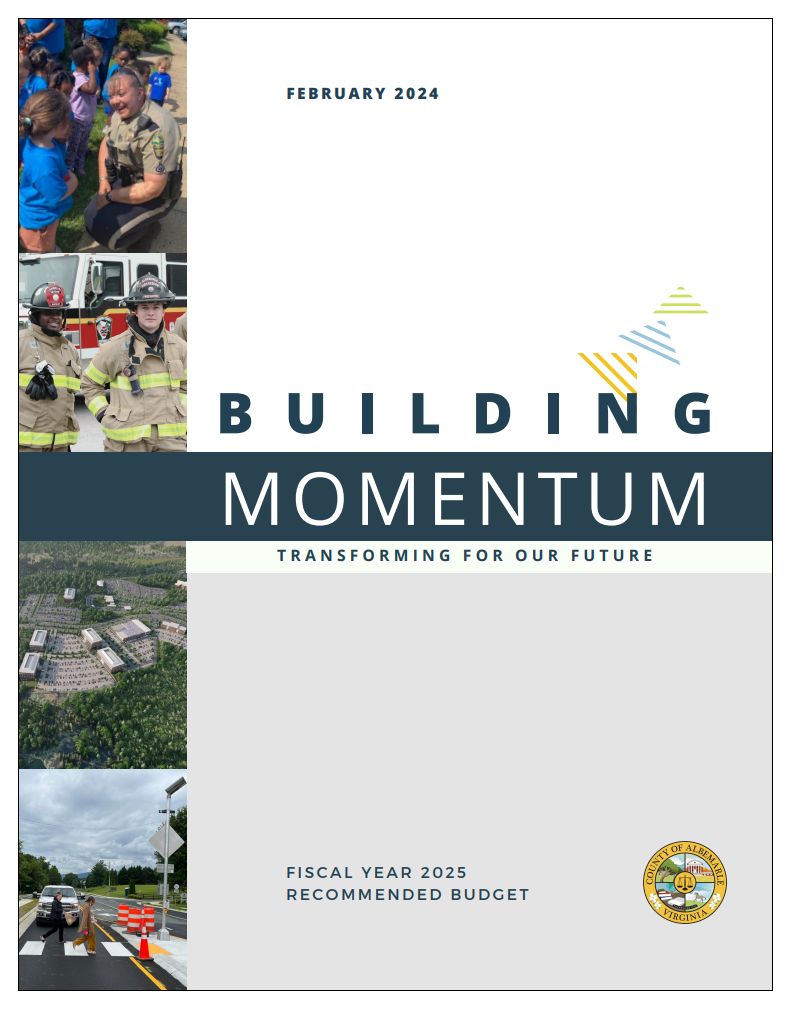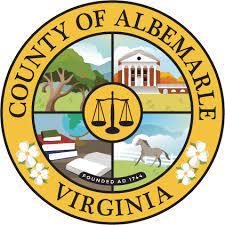There are still about six weeks to go until Albemarle County Supervisors will vote on a budget for fiscal year 2025. There have been three work sessions so far where elected officials go through the document for potential revisions.
“That’s going to be to the tenor of the first few work sessions we have scheduled but I want to point out a milestone on March 25,” said Andy Bowman, Albemarle’s chief of budget, at the first work session on March 6. “On that day, the Board of Supervisors will be asked to take action to propose a budget for public hearing and to propose tax rates for advertisement.”

Throughout the work sessions, county staff keep track of potential adjustments Supervisors might want to make in the budget. One item is how much money might Albemarle raise if they match Charlottesville City Council’s willingness to increase the transient lodging tax. (view the March 6, 2024 presentation)
One of the first items Supervisors requested after first seeing County Executive Jeffrey Richardson’s $629 million budget request was a list of items not funded. That list can be reviewed here.
“This total all-funds budget is an increase of about $74 million or 13 percent,” Bowman said. “When we look at the total budget, one of the biggest variables is the capital budget. By nature of capital projects, we’ll stop and start and change year to year based on what may be programmed.”
Albemarle plans to borrow about $62 million in FY25 with some of that going to pay for construction of a new elementary school in the county’s southern feeder pattern.
But capital is for another day. The topic for the first presentation dealt with the general fund budget which is based on $432.2 million in revenues. The FY25 budget is based on no increase on any of the tax rates.
“I will point out that food and beverage is at the statutory at six percent and the county does not have enabling authority to increase that one further, “ Bowman said.
Sixty-six percent of the general fund budget comes from real property taxes which are based on a rate of $0.854 per $100 of assessed value. Each penny is worth $2.9 million in revenues, but a formula with Albemarle County Public Schools would grant that agency 54 percent of any new funding that came in and ten percent would go to capital and debt service.
Bowman noted there is a 4.07 percent increase in real property assessments in 2024 and Virginia law mandates that the county tell community members about a “lowered” or “effective” tax rate.
“What this tax rate is essentially saying is that if the Board were to adopt a tax rate that essentially offsets that growth of 4.07 percent from reassessments, what would that tax rate be?” Bowman said. “In this case that is $0.821 percent per $100 of assessed value.”
Bowman also presented information on a concept known as the fund balance. This can be described as all of the money left over after spending in previous years, though some of it is already committed.
“If you were look into the audit, or if you look into our adopted budget, you would see at the end of fiscal year 2023, there is an unassigned fund balance of $91.3 million,” Bowman said. “To give a breakdown of what that funding is, most of that balance is committed in FY2024 based on the Board’s financial management policies.”
Those policies?
- $48.1 million is set aside to meet requirements for the county to continue to maintain a AAA bond rating that requires cash on hand in case of an emergency
- $9.6 million is in a budget stabilization reserve policy intended to be a first pool of funds to draw upon if there is a budget shortfall or some other need for funding without drawing from the AAA set-aside
- $9.1 million goes to a school reserve for education
- $15.6 million has been spent already based on decisions made by the Board of Supervisors in the current fiscal year
- Another $8.8 million goes to one-time expenses including $1.3 million to a fund for health care for county employees and $2 million toward the county’s housing fund
At this point, Bowman took a pause to seek questions from Supervisors. Scottsville District Supervisor Mike Pruitt had a question about that $48.1 million.
“Is this like an operating slush fund for overruns and unexpecteds that we have in a given year?” Pruitt asked. “How should I interpret what this is doing? Is it carried over year to year? Is it used to pencil out next year’s budget?”
Bowman said the expectation from the rating agencies that grant the AAA bond rating is that the funding is to be there for an emergency and replenished if any of the funds are used.
Jacob Sumner, the county’s chief financial officer, had a further explanation of why bond agencies want to see cash-on-hand equal to ten percent of the budget.
“This is one of the key metrics the ratings agencies and the financial markets look at to see what is our stability, our fiscal stability,” Sumner said. “The dollar amount that you see there is an accumulation over years and years and year and years of solid budget planning and fiscal stewardship.”
Pruitt questioned whether Albemarle was being too conservative and whether there needed to be such a cautious approach.
“I do think that the purpose of government and government money is to react to needs that are before us and while I appreciate that fiscal stability and proper planning are important considerations and things, I don’t think it is a goal of government,” Pruitt said.
Bowman said he would come back with more information on fund balance policies for other localities with AAA bond ratings.
Supervisor Ned Gallaway defended the county’s decision a few years go to create the budget stabilization reserve that seeks to set aside two percent of the budget.
“The two percent stabilization reserve isn’t so much of a requirement as a choice this Board made and I support that choice,” Gallaway said. “I think the pandemic is probably the closest lesson we got and we were able to maneuver that thanks to Mr. Richardson’s leadership and the staff of getting through that without touching the ten percent.”
Gallaway said when the pandemic hit, the stabilization reserve provided a cushion at a time when it was not yet known whether emergency funding would come from the federal government in the form of the CARES Act and the American Rescue Plan Act.
“Before we knew ARPA money was coming, we locked away money for cash needs that we did know if we would need,” Gallaway said.
Supervisor Jim Andrews drew attention to the amount of revenue received from the University of Virginia, an entity exempt from property taxes.
“It’s a whopping $133,000 but it’s dropped by 33 percent and I was curious as to how that amount gets determined and estimated,” Andrews said. “I really don’t understand it.”
Bowman said he would return to the Board with an explanation.

After going through the revenues, Bowman took Supervisors through some of the highlights in expenditures. Here are some related to human resources.
- $4.3 million to implement the Classification and Compensation Study and a two percent cost of living adjustment in the current fiscal year
- $1.1 million for a mid-year salary review to bring position to market rate
- $1.5 million to cover the cost of providing health care insurance to employees
Bowman said as a result of the work to date, turnover has declined from 13.4 percent in FY23 to a projected rate of 11.3 percent in FY24. There were 35 vacancies on March 6 compared to a peak of 80 during FY23.
There are fewer new positions being recommended to be added in FY25 than in recent years with 6.6 full-time equivalents. Between FY20 and FY24, an average of 31.3 full-time equivalents was added.
More from Albemarle County’s budget as I can get through it.

Before you go: The time to write and research of this article is covered by paid subscribers to Charlottesville Community Engagement. In fact, this particular installment comes from the March 18, 2024 edition of the newsletter and podcast. To ensure this research can be sustained, please consider becoming a paid subscriber or contributing monthly through Patreon.













